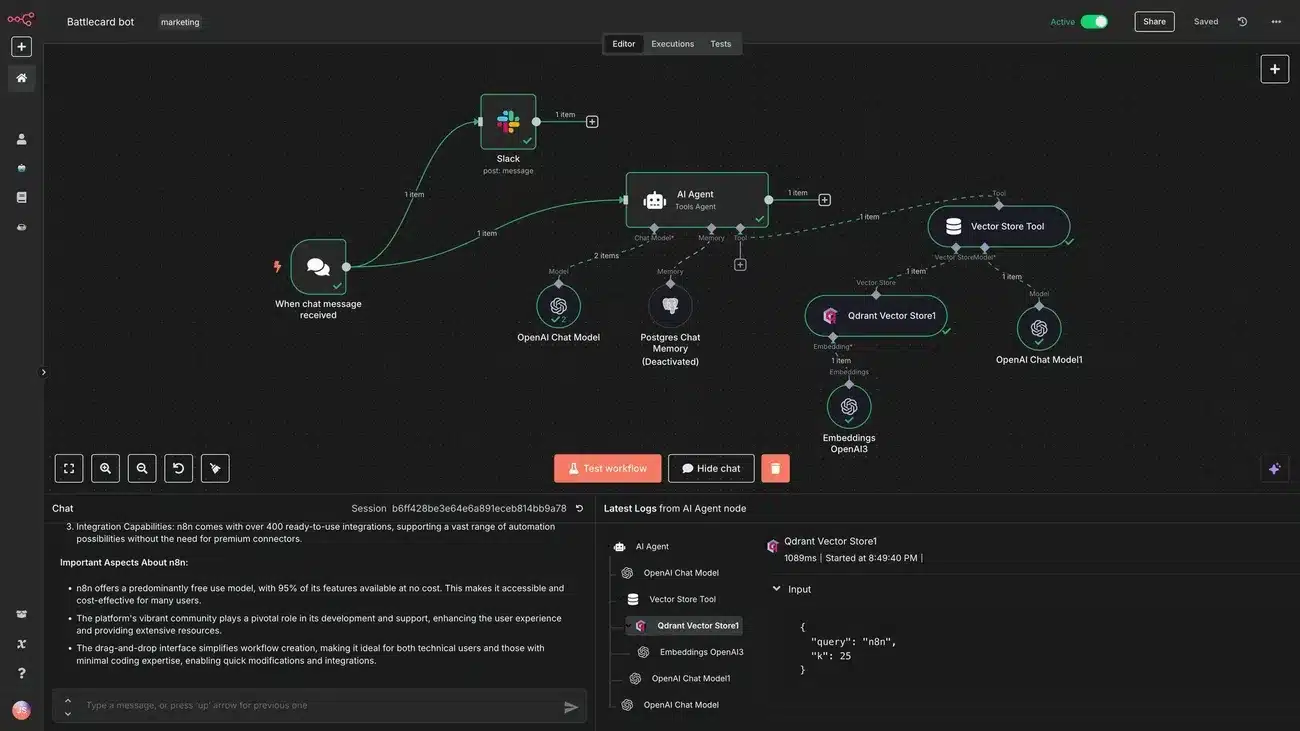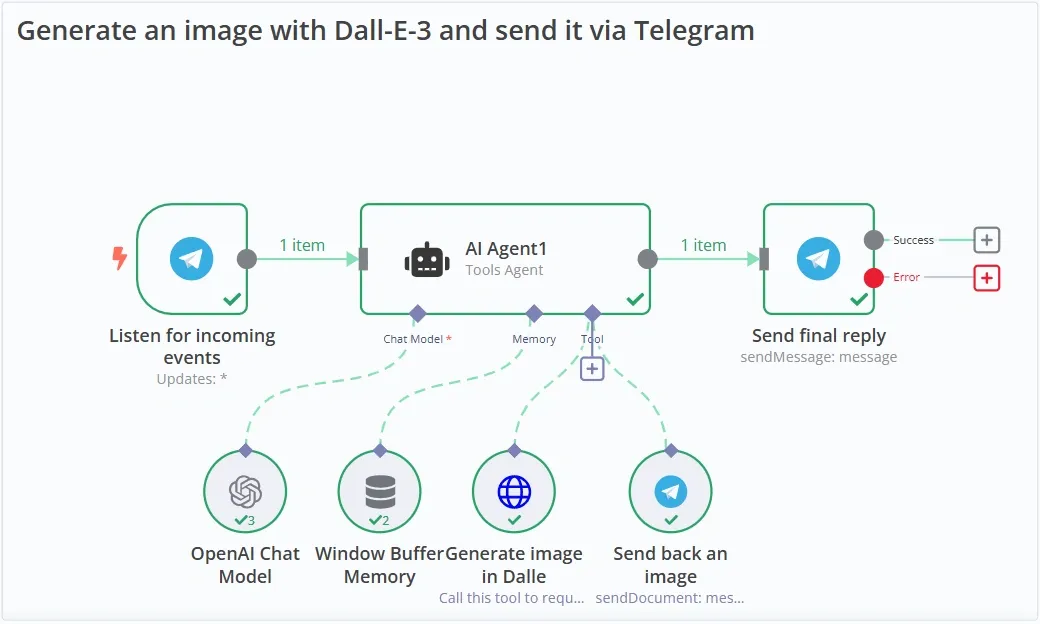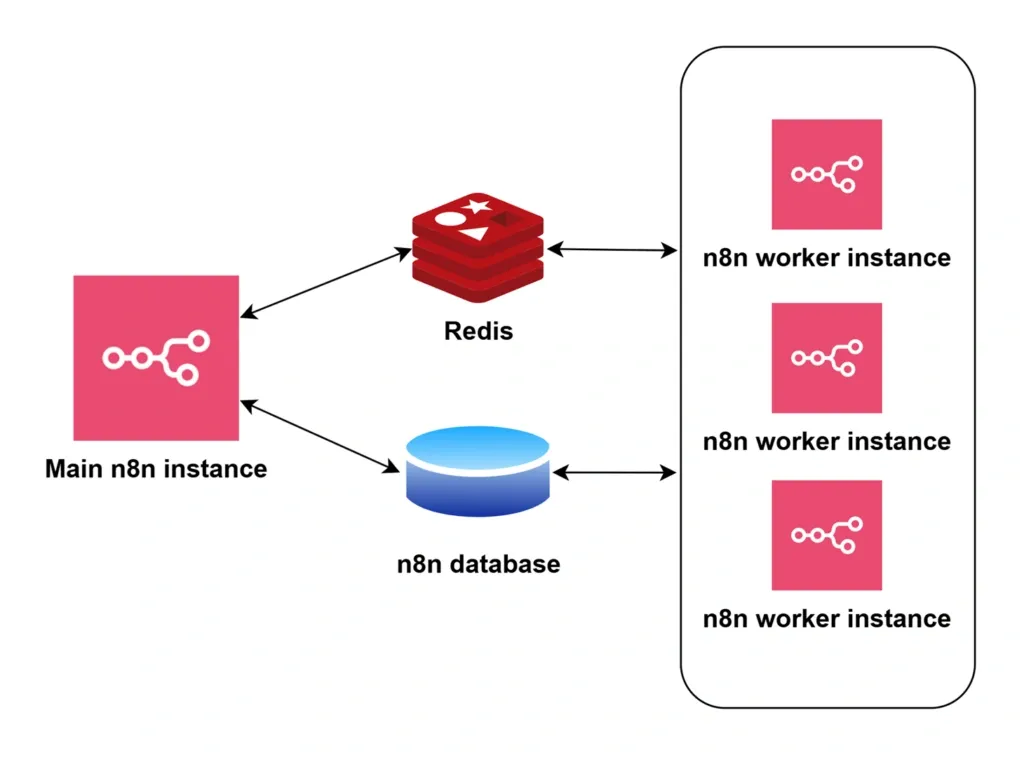How much time do you spend each day on repetitive tasks that you could automate? n8n is an open-source automation tool that allows you to create custom workflows without relying on proprietary solutions like Zapier or ActiveCampaign. What makes n8n special is its visual interface with templates for common workflows, where each action is automatically executed after a specific trigger.
You’ll learn how to connect hundreds of services, tools, and APIs to automate virtually any process. This platform goes far beyond being a simple “free Zapier” – it’s a professional-grade tool that you can install wherever you prefer: on your laptop, on a Docker-enabled server, on a budget VPS, on Kubernetes, or directly in the n8n cloud. If you’re looking for a budget-friendly solution, you’ll be happy to know that the self-hosted n8n is completely free to use, while the cloud version starts from about €20 per month, depending on the volume of automations.
In this article you will discover what exactly n8n is, how its visual logic works where each workflow is a graph composed of connected nodes, and why it is changing the way we work with technology. We will also show you how to integrate Artificial Intelligence models into your automations and analyze their cost-benefit ratio compared to other similar platforms.
Key Points Automation Workflows
Discover how n8n is revolutionizing business automation in 2025 with these key insights:
• n8n is free for self-hosting: Unlike Zapier or Make, you can use n8n for free on your own server, paying only for the infrastructure (€9-€14/month).
• Billing by complete workflow, not by operation: A flow that processes 1,000 records counts as a single execution, being up to 10x cheaper than competitors.
• Native AI integration: Connect directly with OpenAI, HuggingFace, and LangChain to create conversational agents and intelligent automations without additional code.
• Full data and privacy control: Being open-source and self-hosted, you maintain complete sovereignty over sensitive information, complying with regulations such as GDPR.
• Superior technical flexibility: Allows custom JavaScript/Python, access to unlimited APIs, and creation of complex workflows without “premium app” restrictions.
With over 400 integrations available and a community of 200,000+ users, n8n is positioned as the ultimate solution for businesses looking for advanced automation without relying on expensive proprietary platforms.
In VerifyEmails we have integrated the services of phone verification, email checker, correction of first names/surnames and validation of postal addresses in our n8n templates with AI agents.
What is n8n and why is it key in 2025?
Image Source: N8N
Automation tools have evolved considerably, and few offer the control and flexibility that n8n provides. With more than 133,700 stars on GitHub and a community of more than 200,000 members, this platform is radically changing how companies implement their automations.
N8n What It Is: Definition and Purpose
N8N (pronounced “en-eight-en” or “nodemation”) is an open-source workflow automation platform that visually connects applications, services, and data using a graphical interface. Originally designed as “nodemation,” this tool makes it easy to create custom automations without requiring advanced programming knowledge.
Its architecture works with interconnected nodes, where each node represents a specific action or event. N8N goes beyond simple “if this, then that” connections – it allows you to create complex flows with branching, merging, and advanced data manipulation.
The main purpose of n8n is to eliminate repetitive tasks by connecting different applications, platforms, and APIs. Currently, it offers integration with more than 200 popular services, and thanks to its HTTP Request node, it can connect to virtually any service that has a public API.
Differences between n8n and other no-code platforms
Although n8n shares basic functionality with platforms such as Zapier or Make (formerly Integromat), it has important distinguishing features:
Technical focus: n8n is geared towards technical teams and developers, with an interface that allows for both visual development and code deployment.
Superior flexibility: Unlike Zapier, n8n doesn’t charge extra for running advanced workflows with many operations or tasks, and allows JavaScript or Python to be written directly into your flows.
Without premium apps: All integrations are available at no additional cost, eliminating the limitation of “premium apps” that other platforms present.
Transparent pricing model: Your billing is based on complete workflow executions, regardless of their complexity.
By 2025, n8n particularly stands out for its ability to create advanced AI agents and intelligent workflows, becoming a hub for the integration of AI technologies with real-world applications.
Advantages of being open-source and self-hosted
The most distinctive aspect of n8n is its open-source nature and the possibility of self-hosting. This feature provides significant advantages:
Total data sovereignty: By self-hosting n8n, you maintain complete control over your sensitive data, API keys, and business process logic, making it easier to comply with regulations like GDPR.
Scalability at fixed cost: Unlike platforms that charge per operation, a self-hosted n8n allows you to run unlimited workflows without increasing costs when your business volume grows.
Absolute flexibility: You can integrate n8n with any internal tool, legacy system, or specific database, creating custom connectors that perfectly reflect your unique processes.
Flexible deployment options: You can install n8n using npm for quick testing, or use Docker for a cleaner environment and set up your preferred database.
Economically advantageous: The self-hosted version is free for internal, non-commercial or personal use, while the cloud version starts at approximately €20 per month.
Remember that the choice between self-hosting and cloud version will depend on your technical resources, security needs and volume of automations.
How n8n works: nodes, workflows, and visual logic
Image Source: n8n Blog
By exploring the n8n interface, you’ll quickly discover how it works based on a visual system of interconnected nodes. This architecture allows you to create powerful automations without the need for extensive coding.
Structure of a workflow in n8n
n8n works as an ETL (Extract, Transform, Load) tool that allows you to extract data from multiple sources, transform it according to your needs, and load it wherever it is required. Each workflow is a visual diagram where data flows from one node to another.
Data in n8n has a specific structure: it is transmitted as arrays of JSON objects, where each element is called an “item”. This structure is essential to understand how nodes process information:
[
{
json: {
nombre: "Juan",
email: "juan@ejemplo.com"
}
}
]
When you design a workflow, each node performs its specific action on each incoming data item, allowing you to manipulate the information precisely before sending it to the next step.
Types of nodes: trigger, action, conditional
n8n organizes its nodes into functional categories that determine their behavior within the workflow:
- Trigger nodes: They initiate the workflow in response to specific events (such as receiving a message, a change in a spreadsheet, or a scheduled schedule).
- Action nodes: They execute specific tasks such as sending emails, updating databases or manipulating data.
- Conditional nodes: Split the workflow based on specific conditions. The “If” node allows you to create branching based on comparisons, while “Switch” offers multiple conditional outputs.
In addition, n8n includes specialized nodes for data transformation such as “Split Out” to separate items with lists into multiple items, and “Aggregate” to group separate items.
N8n Templates: Ready-to-use templates
To streamline your creation process, n8n offers an extensive library with thousands of pre-designed templates. These templates range from basic business automations to complex AI workflows.
When you create a new workflow, you can choose to start with a blank canvas or use an existing template. Templates provide you with:
- Help to get started quickly
- Practical examples of what you can build
- Best practices for creating your own workflows
Popular integrations: Google Sheets, Slack, APIs
N8N stands out for its more than 400 pre-configured integrations. Among the most commonly used are:
- Google Sheets: Allows you to create, modify, and read spreadsheets with actions such as “Append Row”, “Get Row(s)”, or “Update Row”.
- Slack: Makes it easy to automate messages, channels, and files with operations such as “Send Message” or “Create Channel”.
- HTTP Request Node: Connects you to any service that has a REST API, greatly expanding the integration possibilities.
n8n’s visual interface comes to life with fast feedback loops, allowing you to build step-by-step. The results appear next to your settings at each stage, and you can run only the last step without having to activate the entire sequence.
Installation and deployment: on-premises, Docker, or cloud
Image Source: Medium
Ready to get n8n up and running in your environment? We’ll show you how to deploy n8n according to your technical needs and budget. Let’s discuss each alternative so you can start automating your processes quickly and securely.
What do you need to install n8n?
For a successful n8n installation, you must meet certain minimum requirements. In terms of hardware, n8n doesn’t consume a lot of CPU resources, but you do need at least 1GB of RAM, although we recommend 2GB for optimal performance. For storage, 5-10 GB of free space is enough to get you started, although 20 GB would be ideal for active use.
Regarding the software, you can choose between:
- Node.js: Recommended LTS versions (16.x or 18.x)
- Docker: The Cleanest and Most Isolated Option
- Database: SQLite (default) or PostgreSQL for production environments
Remember that by default, n8n creates a SQLite database if none exists in the specified location. However, for production environments, we recommend using PostgreSQL for its robustness and scalability.
Step-by-step: how to install n8n
Step 1: Install with Node.js
- Download Node.js from nodejs.org (LTS version)
- Open your terminal and run:
npm install -g n8n - Start n8n with the command:
n8n - Access through http://localhost:5678
Step 2: Install with Docker (we recommend this option)
For rapid deployment and testing:
docker run -it --rm -p 5678:5678 n8nio/n8n
For persistent use with saved data:
docker run -d
--name n8n
-p 5678:5678
-v ~/.n8n:/home/node/.n8n
n8nio/n8n
The second option mounts a volume to save your workflows and credentials permanently. In addition, you can use Docker Compose for more comprehensive configuration and environment management.
N8N GitHub: Find all the documentation you need
Need help with setup? The official n8n documentation is available on docs.n8n.io, while the source code is on GitHub. These resources give you detailed guides on:
- Advanced workflow configuration
- Integration with external APIs
- Creating Custom Nodes
- Troubleshooting Common Issues
The community actively maintains the repository under a Fair-code license, allowing it to be used free of charge for personal or internal non-commercial cases.
Secure your installation: security settings
Once n8n is installed, you need to secure your instance. We recommend following these best practices:
Step 1: Set up basic authentication using environment variables:
N8N_BASIC_AUTH_ACTIVE=true
N8N_BASIC_AUTH_USER=admin
N8N_BASIC_AUTH_PASSWORD=contraseñasegura
Step 2: Implement HTTPS with Let’s Encrypt TLS certificates
Step 3: Place n8n behind a reverse proxy like Nginx or Traefik
Step 4: Update regularly to receive security patches
If you handle sensitive information, consider two-factor authentication (2FA) for users as well. For corporate environments, you can set up Single Sign-On (SSO) and perform security audits to identify potential risks.
AI Automation: How to Integrate LLM Models into n8n
Image Source: n8n Blog
The integration of Large Language (LLM) models into n8n opens up incredible possibilities for intelligent automations. n8n uses LangChain to simplify the development of complex interactions with LLMs, allowing multiple prompts to be chained, decision-making to be implemented, and interaction with external data sources.
Using AI Nodes: OpenAI, HuggingFace, LangChain
What options do you have to integrate AI into your workflows? n8n offers native integrations with a variety of AI vendors:
- OpenAI: Connect with GPT-3.5, GPT-4, and DALL-E for text and image generation
- HuggingFace: Allows you to use open-source models such as Mistral-7B
- Ollama: Facilitates the deployment of local LLMs for greater privacy
- LangChain: Provides components such as Memory, Agents, and Text Splitters
These integrations allow you to create workflows that leverage AI to automate tasks such as data analysis, content generation, or natural language processing.
Prompt injection and good security practices
When deploying LLM models, you should consider threats such as prompt injection attacks. They attempt to manipulate the AI through malicious inputs to obtain sensitive information or execute unauthorized actions.
To prevent these risks, we recommend that you follow these practices:
- Implement ticket validation and sanitization before sending them to the model
- Use toast messages to define allowed behaviors
- Apply the principle of least privilege to your AI agents
- Monitor and record all interactions with AI
n8n offers specific workflows to protect against these attacks, such as the “GPT-4O Security Defense System” that detects malicious patterns and sanitizes inputs.
Conversational Agent Automation
n8n allows you to create advanced conversational agents using specific nodes such as “Conversational Agent”. These agents can:
- Maintaining context using memory nodes
- Make decisions based on user input
- Access external tools when needed
- Process and respond in natural language
Do you need to implement AI automation for your business? Contact us to learn about our workflow automation services with artificial intelligence .
Example: AI support chatbot and Telegram
A popular use case is the creation of a support chatbot on Telegram. Here’s how to create this workflow step by step:
Step 1: Receive messages from users on Telegram
Step 2: Process the content using an LLM model such as OpenAI
Step 3: Generate contextualized responses or create images as needed
Step 4: Return the response to the user on Telegram
You can also implement advanced features such as daily usage limits per user, dynamic model selection, or interaction logging in Google Sheets.
Comparison and costs: n8n vs Make, Zapier and others
What’s the best option for your budget and specific needs? The cost model is critical to the long-term viability of any automation platform. We show you the key differences between the main alternatives.
N8n Pricing: Self-hosted vs. Cloud
N8N offers you two main deployment options with very different cost structures:
- Self-hosted version (Community Edition): Completely free under the Sustainable Use license. You only pay for your infrastructure, with server costs hovering around €9-€14 per month for an entry-level machine.
- Cloud version: Starts at €19.08/month (annual billing) for 2,500 workflow runs, with options like the Pro plan at €47.71/month for 10,000 runs.
Remember that n8n bills for full workflow runs, not individual operations. A workflow that processes 1,000 records counts as a single run.
n8n vs Make: flexibility and control
Make uses a trade-based model that starts at €8.59/month for 10,000 trades. Although it initially seems cheaper, each individual action within a scenario consumes a trade, quickly making complex flows more expensive.
If you need more technical control, n8n gives you:
- Full JavaScript and Python support
- Ability to install external packages in self-hosted mode
- File system access and complex HTTP requests
Advantages over Zapier in complex flows
Zapier, with plans starting at €19.07/month for 750 tasks, is significantly more expensive for complex flows. Each step that a data item processes consumes a task in your quota.
For high-volume automations, the difference can be hundreds of euros per month or thousands per year. In addition, n8n offers you:
- No limitation on “premium” apps
- Implementation of sophisticated algorithms
- Increased data privacy with self-hosted option
Fair-code license: what it means for companies
n8n uses the Sustainable Use license under the fair-code model. This means:
- Free use for internal business or personal purposes
- Free distribution for non-commercial purposes only
- Restrictions if you offer n8n as a service to third parties
If you’re planning for multi-tenant SaaS or white-label integration, there are Enterprise and Embedded licenses that require specific business agreements.
Conclusion
N8N represents a robust and flexible solution for automating business and personal processes by 2025. This platform stands out for its open-source nature, which gives you full control over your data and workflows without the limitations of proprietary solutions. You can choose between the free self-hosted version or the cloud option depending on your specific needs and available technical resources.
The node-based visual interface makes it easy to create complex automations, allowing you to connect hundreds of different services without the need for advanced programming knowledge. In addition, n8n stands out for its excellent integration with artificial intelligence technologies through specific nodes for OpenAI, HuggingFace and LangChain, enabling the creation of conversational agents and intelligent workflows.
From an economic point of view, n8n offers significant advantages over competitors such as Zapier or Make, especially for complex or high-volume workflows. Its billing model for full runs, not individual trades, is much more cost-effective in the long run for most use cases.
Deployment flexibility is another important differentiating factor. Whether it’s on your own server with Docker, on a budget VPS, or directly in the n8n cloud, you’ll always remain in control of your automations and data. If you’re looking for a robust solution to eliminate repetitive tasks and integrate artificial intelligence into your processes, n8n is worth your consideration.
The result? Less time spent on manual tasks and more resources to focus on what really adds value to your business. With tools like n8n, intelligent automation has become the present, not the future.
FAQs
Q1. What is n8n and how does it differ from other automation tools?
N8N is an open-source workflow automation platform that allows you to visually connect applications and services. It differentiates itself by being self-hosted, offering greater technical flexibility, and a pricing model based on complete workflow executions rather than individual operations.
Q2. What are the advantages of using n8n compared to Zapier or Make?
n8n offers greater technical control, allows custom scripts in JavaScript/Python, has no limitations of “premium apps”, and is more economical for complex workflows. In addition, the self-hosted version is free, paying only for the infrastructure.
Q3. How does n8n integrate artificial intelligence into its automations?
n8n provides specific nodes for integrating AI services such as OpenAI, HuggingFace, and LangChain. This makes it possible to easily create conversational agents, generate content with AI, and automate complex tasks that require natural language processing.
Q4. What installation options does n8n offer and what are its requirements?
n8n can be installed locally using Node.js, deployed with Docker, or used in the cloud. Minimum requirements include 1GB of RAM (2GB recommended), 5-10GB of storage, and Node.js LTS or Docker. For production, we recommend using PostgreSQL as your database.
Q5. How does n8n handle data security and privacy?
Being self-hosting, n8n allows you to maintain full control over sensitive data. It offers basic authentication options, support for HTTPS, and can be configured behind a reverse proxy. For added security, it is recommended to implement two-factor authentication and perform regular updates.








